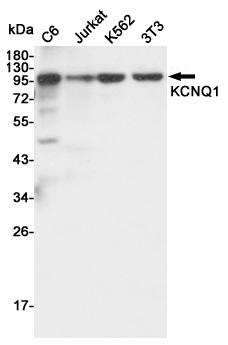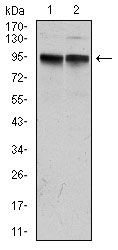-
Product Name
Anti-KCNQ1 (7E1) Mouse antibody
- Documents
-
Description
KCNQ1 (7E1) Mouse monoclonal antibody
-
Tested applications
WB, FC
-
Species reactivity
Human
-
Isotype
Mouse IgG2b
-
Preparation
Antigen: Purified recombinant fragment of human KCNQ1 expressed in E. Coli.
-
Clonality
Monoclonal
-
Formulation
Ascitic fluid containing 0.03% sodium azide.
-
Storage instructions
Store at 4°C short term. Store at -20°C long term. Avoid freeze / thaw cycle.
-
Applications
WB: 1/500 - 1/2000
FC: 1/200 - 1/400
ELISA: 1/10000
-
Validations

Western blot detection of KCNQ1 in C6,Jurkat,K562 and 3T3 cell lysates using KCNQ1 mouse mAb (1:3000 diluted).Predicted band size:95KDa.Observed band size:95KDa.

Western blot analysis using KCNQ1 mouse mAb against MCF-7 (1) and A431 (2) cell lysate.

Flow cytometric analysis of MCF-7 cells using KCNQ1 mouse mAb (green) and negative control (red).
-
Background
Swiss-Prot Acc.P51787.This gene encodes a voltage-gated potassium channel required for repolarization phase of the cardiac action potential. This protein can form heteromultimers with two other potassium channel proteins, KCNE1 and KCNE3. Mutations in this gene are associated with hereditary long QT syndrome 1 (also known as Romano-Ward syndrome), Jervell and Lange-Nielsen syndrome, and familial atrial fibrillation. This gene exhibits tissue-specific imprinting, with preferential expression from the maternal allele in some tissues, and biallelic expression in others. This gene is located in a region of chromosome 11 amongst other imprinted genes that are associated with Beckwith-Wiedemann syndrome (BWS), and itself has been shown to be disrupted by chromosomal rearrangements in patients with BWS. Alternatively spliced transcript variants have been found for this gene.
Related Products / Services
Please note: All products are "FOR RESEARCH USE ONLY AND ARE NOT INTENDED FOR DIAGNOSTIC OR THERAPEUTIC USE"
